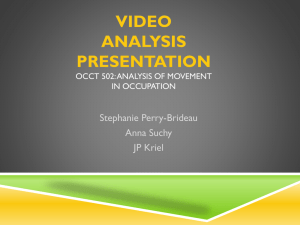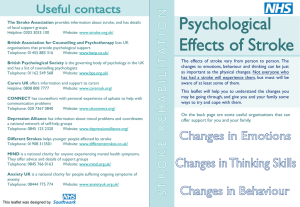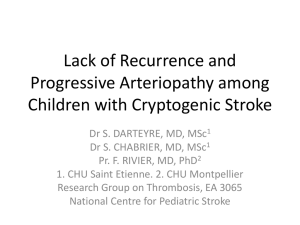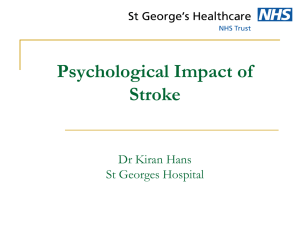PowerPoint Document
advertisement
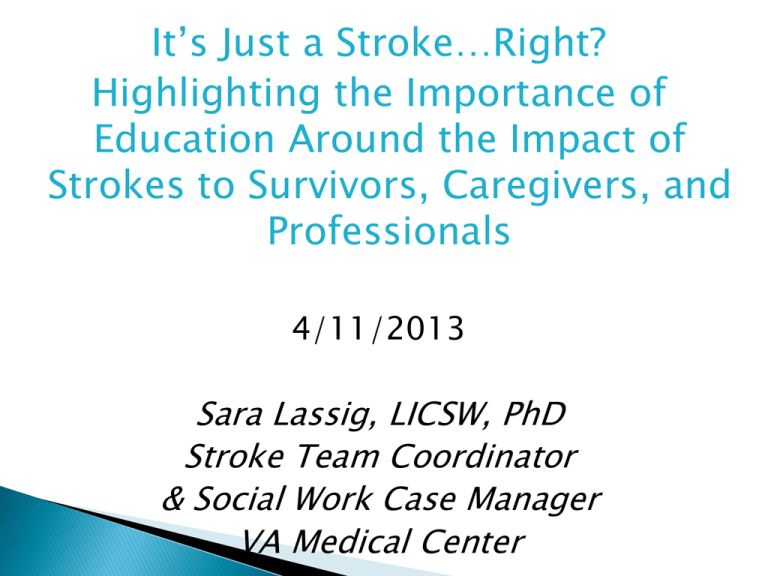
It’s Just a Stroke…Right? Highlighting the Importance of Education Around the Impact of Strokes to Survivors, Caregivers, and Professionals 4/11/2013 Sara Lassig, LICSW, PhD Stroke Team Coordinator & Social Work Case Manager VA Medical Center 75 year old stroke patient in acute rehab George Bill 32 year old TBI patient in acute rehab George Bill George Bill Traumatic Brain Injury (TBI): Injury to the brain caused by an external force. Common causes: MVA’s, falls, striking the head, gunshot wounds Acquired Brain Injury (ABI): Includes Cerebral Vascular Accidents (strokes) and loss of oxygen to the brain (Hypoxic Brain Injury Lack of uniformity around the inclusion of TBI as a part of the more “umbrella” term “ABI.” TBI One type of ABI Stroke is the 3rd leading cause of death in the United States. Stroke is the leading cause of serious, longterm disability in the United States. Each year, approximately 795,000 people suffer a stroke. Nearly three-quarters of all strokes occur in people over the age of 65. (American Stroke Assoc) Left Brain Stroke: - Damage to the left side of the brain can weaken or paralyze the right side of the body, and may cause problems with speech and with the understanding of spoken and written language. Right Brain Stroke: - Damage to the right side of the brain can weaken or paralyze the left side of the body and may cause lack of awareness and neglect of the left side of the body. Cerebellar Stroke: -Damage to the cerebellum can cause lack of balance or coordination on the same side of the body. It can also cause slurring of speech. Brain Stem Stroke: -Damage to this part of the brain can cause serious impairment in this life- sustaining functions. Symptoms of dizziness, slurred speech and double vision are also common. It may also cause paralysis on both sides of the body. Beyond hemiparesis, aphasia, neglect, and apraxia… ◦ Emotional reactions ◦ Confusion ◦ Changes in eating, sleeping, and thinking ◦ Depression ◦ Fatigue Severity of impairment Extent of emotional reactions and changes Family Reactions Research Pseudobulbar Affect Emotional lability, reflect crying Rapid mood changes Crying or laughing that doesn’t match mood Depression ** Anxiety Frustration Fatigue *Based as well on area of the brain affected* Ambiguous Loss Physical absence with psychological presence. ◦ (Example: severe hemiparesis) Psychological absence with physical presence. ◦ (Example: severe fluent aphasia) Ambiguous Losses are most difficult of all losses. ◦ “Where is he/she?” Family/caregiver/support system that is available to stroke survivor Level of impairment Role in the family prior to the stroke Available resources “Status” of the stroke survivor ◦ Research on care provision Physical age Body image, “how old I feel” Perception of stroke survivor vs. perception of others Era / Generation – Experience with adversity Emotional responses linked to age and stage variations Loss of control Loss of self-image Loss of Independence Fear of stigma Fear of abandonment Fear of expressing anger Fear of isolation George Loss of control Loss of self-image Loss of Independence Fear of stigma Fear of abandonment Fear of expressing anger Fear of isolation Bill Do we change our care based on age alone? Do we change our expectations of patient/stroke survivor behavior based on diagnosis? Do we expect more? Less? Are we more patient? Are we providing the same quality of education for the patient and family as we might for other brain injuries? Are we as care providers educated? Individuals who have experienced a stroke have a brain injury. Professionals providing care to stroke patients have the responsibility to be educated on the resulting effects of strokes, in order to: ◦ Provide improved patient and family care ◦ Educate and support stroke survivors and their families Bob – 87 Joe - 65





